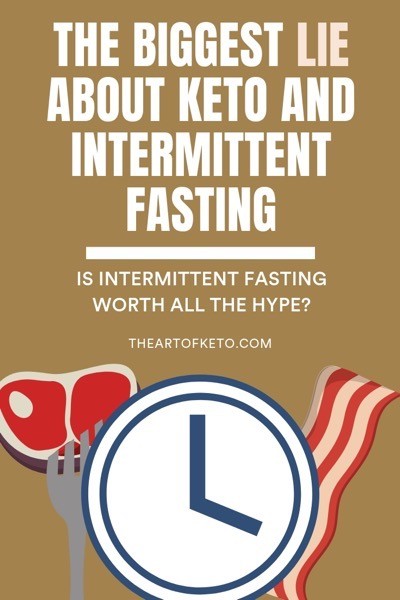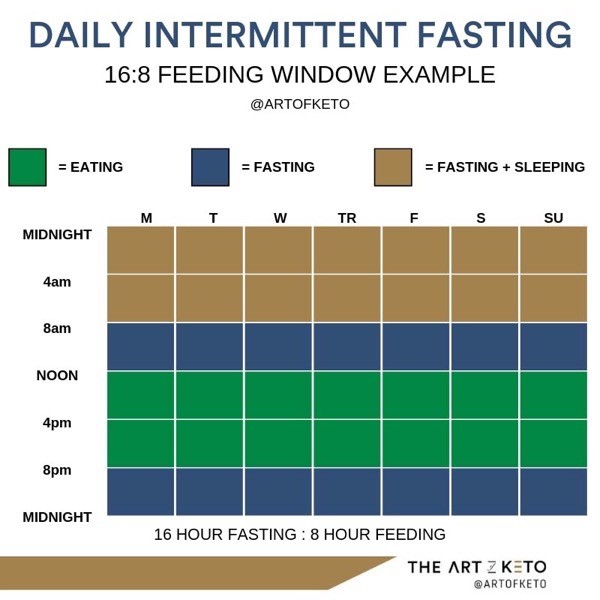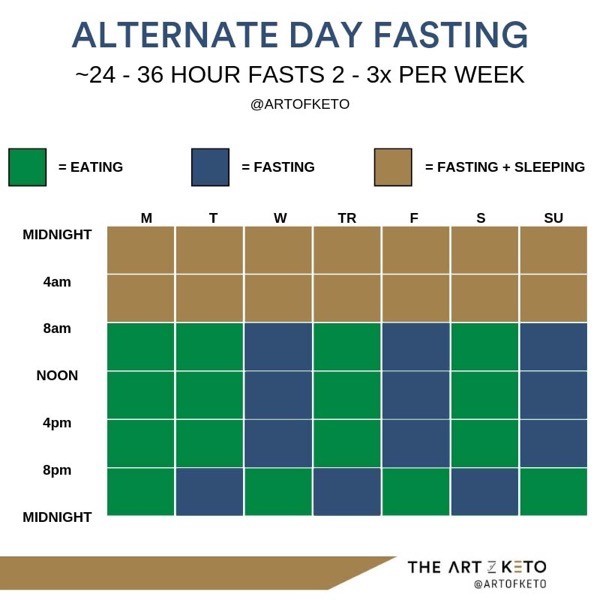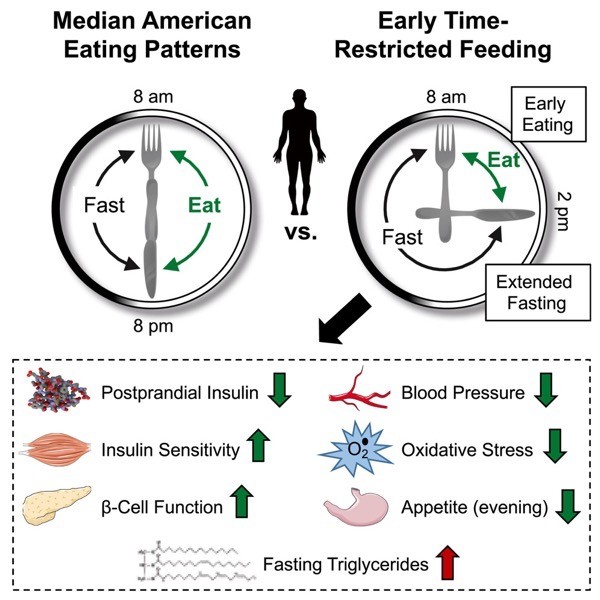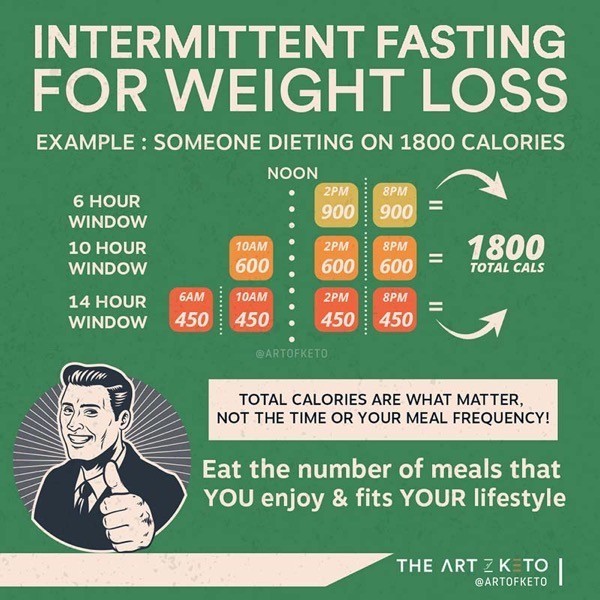Keto and intermittent fasting are all the rage these days. I mean, you usually don't hear about one without eventually hearing about the other.
But is there any benefit in combining the two for the purposes of weight loss?
There may be other benefits, weight loss aside, to combine keto and intermittent fasting, but is there any inherent fat loss benefit?
Can you combine keto and intermittent fasting?
Of course, you can combine keto and intermittent fasting, they go together like peanut butter and jelly. However, know that one also doesn’t require the other, and most people find it easier to implement intermittent fasting on a ketogenic based diet than a carb based one.
But we’ll get to that.
I am going to assume you know what keto is already, so we won't be doing an entire keto 101 in this article. If not, give my ketogenic diet guide a read through, but in general…
What is Keto?
Most websites and people would have you believe that keto is a “diet” or a certain type of “food,” and they would be right… to an extent.
In reality, ketosis is a metabolic state where your body essentially runs on ketones (fat) instead of glucose (sugar).
When you limit or eliminate your carbohydrates, your body has no choice but to break down the fat from the food you eat AND the fat on your body to create energy for your body and your brain.
It’s kind of like when you have a hankering for cereal and you run out of milk… so what do you do? You have to use water instead.
Basically, your body ends up running out of sugar and it’s forced to use what’s left… your fat stores.
Blasphemy, I know… but don’t pretend like you’ve never done that in your lifetime. Besides, you’re on a keto diet now so you ain’t about that cereal life anymore.
What is intermittent fasting?
In the most general of cases, intermittent fasting is combining periods of eating with periods without eating. Therefore, Intermittent fasting is not a diet per se; instead it's a pattern or schedule of eating.
When I say intermittent fasting is not a diet it's because IF doesn't change what you eat, it changes when you eat. That said, weight loss is the most common reason people give intermittent fasting a shot.
Examples of different intermittent fasting schedules
There is no one way to implement intermittent fasting, so I've outlined a few popular methods down below.
DAILY
One of the most popular ways to implement intermittent fasting is a daily fast of 16 hours followed by an 8-hour eating window. It really doesn't matter when you start your eight-hour eating window, but most people tend to start it around noon or early afternoon.
The reason most people have their feeding window in the afternoon is that, in general, people find it easier to skip breakfast, rather than dinner. Besides, if you went 16 hours without food and you can spend the first eight hours or so asleep… you would probably find it easier too.
On top of that, allowing for dinner makes it more convenient from a schedule standpoint. You can eat with your family or go out during social events and not be the only person in the room not eating
… because you're fasting.
Personally, I prefer this schedule because I like to go to bed on a full stomach.
As far as daily scheduled intermittent fasts go, people start to either shorten the eating window or even lengthen it slightly. Some might even go as far as to take all the calories for the day and eat it in one big meal.1
Remember, there are no hard or fast rules… if you find yourself slightly hungry before your “eating window,” then go ahead and eat. Vice versa, if you aren’t hungry and want to remain fasted, then remain fasted.
I’ve used this method of intermittent fasting on and off for over 10 years now, but I’m not fanatic about it to the point that it runs my day. If my friends or family go out to breakfast or some friends invite me over to watch the game and nosh on some wings, guess what? I don’t care that it’s outside of my “feeding window.”
WEEKLY
This schedule of intermittent fasting is generally a good way to introduce yourself to intermittent fasting. You pick one day out of the week and simply don’t eat.
It’s really that easy.
If going an entire day from the time you wake up to the time you go to bed seems daunting, try fasting after dinner (6pm for example) from the previous night until dinner (6pm) the following night. In the end, you still technically will have fasted for at least 24 hours and ends up like the (OMAD) one meal a day mentioned in the daily section.
Perhaps one of the biggest benefits of doing a weekly fast is getting over that mental barrier of fasting in the first place. If you’ve never fasted before, this may seem like a daunting task, but successfully completing your first 24-hour fast can help you realize it isn’t as frightening as your head makes it out to be.
ALTERNATE DAY
Alternate day fasting may be the most challenging schedule from a mental standpoint since you will be going without food for about ~36-hours at a time.
For example, you would eat normally on Monday until dinner, then begin your fast until Wednesday morning. Then, you would repeat the process by eating normally Wednesday and beginning your fast Wednesday after dinner and not eating until Friday morning.
Hypothetically, this would yield the most benefits since you are going long periods without food more frequently. Alternate day fasting would likely yield the most weight loss as well since you are going longer periods without food and more likely to have greater caloric deficit.
Assuming you don’t eat like an asshole on the days you do eat.As I said, myself and many other much prefer the 18-hour daily fasts since it’s typically much easier to simply skip breakfast most days. If you do choose to combine keto and intermittent fasting then experiment with the different schedules and see how you feel.
Intermittent fasting. Not to be confused with intermittent dieting or intermittent energy restriction.
In short, intermittent dieting or intermittent energy restriction is NOT the same as intermittent fasting. Intermittent dieting is when you include brief periods, typically days or weeks, where you intentionally aim to MAINTAIN weight between periods of weight loss dieting.
These may be commonly referred to as refeeds or diet breaks.
But we’ll cover that in another article on why it may benefit you in the long run when it comes to losing weight.
Keto and intermittent fasting – They go to gather like peanut butter and jelly.
Keto and intermittent fasting for weight loss.
You may want to combine keto with intermittent fasting to accelerate your weight loss, but probably not for reasons you may have been led to believe. Research suggest that an 8 hour feeding window produces mild caloric restriction and weight loss, without calorie counting. 2
In layman's terms, it caused people to eat less overall. I mean, it makes sense right? You are essentially giving yourself less time to eat.
Which leads me to my second point…
Calories still matter. On a keto diet, when intermittent fasting, or combining keto and intermittent fasting… calories still matter. BUT, as the study suggested, intermittent fasting MAY be a way for you to eat less without really having to count calories.AGAIN, as long as you don’t eat like an asshole during your 8-hour or however long eating window.
Personally, I can still easily manage to overeat in such a short time frame. However, I am an endless pit, and most normal people will find it difficult to cram too much food in such a short period of time
Thus making it a viable option if you can eat “sensibly” during your feeding window.
Reasons why keto and intermittent fasting work well together.
People are more satiated on a ketogenic diet
People tend to eat fewer calories on a ketogenic diet… SPONTANEOUSLY, as in without trying to restrict calories.3 This is important to note since hunger is a primary reasons people fall off most weight loss diets.
There is no conclusive reason to as why this occurs, but one theory is that ketone bodies (our primary fuel source on a ketogenic diet) may suppress appetite.4
Pair intermittent fasting with keto and you have the benefit of:
- Less or no hunger during your fasting window
- Increased chance of weight loss without counting calories
On the flip side…
IF may ease your transition to a ketogenic diet
Intermittent fasting may help transition your body into a state of ketosis over doing a ketogenic diet alone.
During your fasting window, insulin and glycogen decrease, 5 naturally leading your body to start burning fat for fuel. This is one of the driving reasons people even on a carbohydrate-based diet implement intermittent fasting.
I also mention in my article How long does it take to get into ketosis? that intermittent fasting or just plain fasting will help speed up your transition into ketosis.
Intermittent fasting and Keto – Weight loss aside, here are some benefits.
You can type in intermittent fasting in google or your favorite social media platform and you’ll hear things like “autophagy” and IF made me poop rainbows and dream about unicorns.
Don’t get me wrong, you do you… and if you love doing it and you see results, then, by all means, keep doing it!
But if there comes a point where you’re stressing out about if you should eat, what can you eat, can you drink this, but I want this for breakfast, then you’re just better off not worrying about it. In the end, there’re bigger things you can focus on instead of watching the clock for when you can eat.
Up until recently, many of the intermittent fasting benefits you’ve heard (or haven’t heard) were weak at best. Many of the studies which reported benefits could easily be attributed to the weight loss participants experienced versus the actual intermittent fasting.
However, there are recent findings that may suggest intermittent fasting (also known as time-restricted feeding) does have benefits even WITHOUT weight loss.6
The only caveat, the feeding window would be more in line with your circadian rhythm. Meaning, you would eat according to your internal clock.
To simplify, you would have your FASTING window in the evening. Basically, eat during the first 8 hours of the day, generally when the suns out.
Which is probably the opposite of what most people are doing.
This schedule of eating is referred to as Early time-restricted feeding (eTRF) and has been shown to:
- Increase insulin sensitivity
- Lower blood pressure and oxidative stress
- Lower the desire to eat in the evening (so maybe skipping dinner or making it super early might not be as bad as you might think)
- Improve health EVEN in the absence of weight loss
The only problem with this is people are social beings and we eat for reasons beyond hunger, which is a problem it and of itself. It’s also much easier to fast during the day because people are typically busy at work and can focus on other things besides food.
It’s also just my humble opinion, but I think most of the benefits of eTRF stem from the fact that you’re eating earlier in the day versus the actual time restriction.
A large majority of the population suffer from circadian arrhythmia. 7 In today’s society, we tend to stay out (or just up) late, drink alcohol, expose our eyes to artificial light in the evenings, etc. Eating earlier may be a way to re-align our circadian rhythms.
If eTRF sounds like something you want to give a shot, you have my blessing.
Not that you needed it.
That said, intermittent fasting for me makes my day simpler.
Intermittent fasting allows me to eat one less meal, which also means cooking one less meal and therefore stressing about one less meal. When I wake up, I don’t have to worry about breakfast, but can get to other more important tasks at hand.
Like coffee. 😉
I also like to eat more substantial meals.
I’m the type of person that likes to eat HUGE meals and go to bed on a full stomach, whether that’s good or bad is a whole other topic of discussion we’ll save for another day. I’m not advocating you eat huge meals or go to bed on a full stomach, it’s just my preference and what works to keep me adherent to a caloric deficit.
… and remember, in the end a caloric deficit IS required to lose weight. Intermittent fasting can be used as a tool to achieve a caloric deficit whether you want to count calories or not.
Who should try an intermittent fasting Keto approach?
The jury is still out on whether there is an INCREASE in fat loss by using intermittent fasting versus traditional caloric restriction. A systematic review 8 was published in December of 20189 that found no difference.
Both intermittent and continuous energy restriction achieved a comparable effect in promoting weight-loss and metabolic improvements.
– Cioffi et al., 2018
So the jury is still out on whether or not intermittent fasting is MORE effective than if you were to spread your meals throughout the day. This is also assuming you ate the same amount in the ~8-hour window or ~16-hour window.
That said, I would try intermittent fasting if:
- You enjoy less frequent but LARGER meals
- You don’t necessarily find yourself that hungry in the mornings (or evenings)
- It allows you to adhere to your diet over the long term
- You simply want to experiment
The bottom line on Keto and intermittent fasting
You need to be up front and honest with yourself if choosing to utilize intermittent fasting because context is everything. Don’t say that you’re doing it for health, autophagy, [insert reason you give your friends], when in reality it's that you think it burns more fat.
I do believe there are health benefits to intermittent fasting and fasting in general, but I’d be skeptical to assume there is any inherent fat loss benefit to restricting your eating window.
At the end of the day, intermittent fasting isn't magic when it comes to weight loss. If combining keto and intermittent fasting works for you and fits your lifestyle, then by all means…
Implement it.
However, if trying to implement keto and intermittent fasting makes everything much harder, stresses you out, or makes adhering to your diet more difficult, then it's not a worthwhile trade-off.
Keto and intermittent fasting F.A.Q.
Can you do keto and intermittent fasting together?
You can definitely do keto and intermittent fasting together. In fact, keto will make intermittent fasting much easier to adhere to due to its satiating nature.
Do I have to eat keto while intermittent fasting?
No, you do not have to eat keto while intermittent fasting.
Does intermittent fasting cause ketosis?
Intermittent doesn't directly cause someone to go into ketosis. That said, During the tail end of longer fasts it is highly likely that the body is beginning to produce ketones.
Do you fast on a keto diet?
Fasting is up to you whether or not you want to include it for the health benefits or diet adherence.
Is Intermittent Fasting better than Keto?
Intermittent fasting and keto are two entirely separate things. Intermittent fasting is a schedule of when to eat. Keto is a metabolic state achieved by what you eat.
Can I drink coffee during intermittent fasting?
Yes, you can drink coffee or any non caloric beverage during your fasting window.
How often should you intermittent fast on keto?
How often you intermittent fast on keto is dependent on your preference.
How much weight can you lose with intermittent fasting?
How much weight you can lose while intermittent fasting is dependent on your total caloric deficit. The recommendation is to lose between 0.5 – 1.5% of your total bodyweight per week. The more fat you have to lose the more you can expect to lose without risk of losing lean body mass.
How long is intermittent fasting?
The duration in which you intermittent fast is dependent on the method you choose to implement whether that's daily, weekly, or alternate day fasting.
How long does it take to get into ketosis while fasting?
From my experience, it typically takes between 24-48 hours to get into ketosis if completely fasting.
How long does it take for your body to go into ketosis?
How long it tales your body to go into ketosis depends on your previous diet, your activity levels, and what you are currently eating.
Can you go into ketosis in 24 hours?
Yes, it is possible to go into ketosis within 24 hours by fasting. While not always the case, you can typically start seeing low levels of ketones between 24 – 36 hours after starting a fast.
What is a fat fast?
People commonly refer to a fat fast as eating a diet composed of 80 – 90% fat for 4-5 days and limited to 1000-1200 calories broken down in 3-4 meals.

